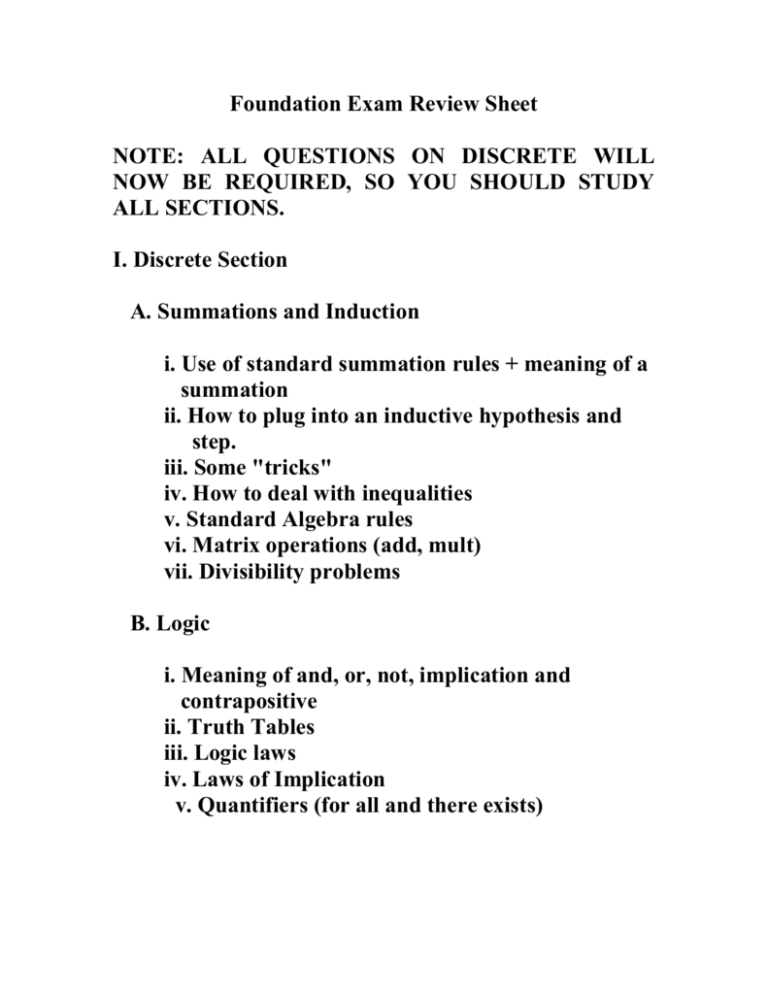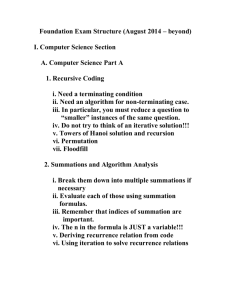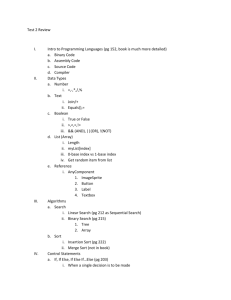ReviewSheetFall07
advertisement

Foundation Exam Review Sheet NOTE: ALL QUESTIONS ON DISCRETE WILL NOW BE REQUIRED, SO YOU SHOULD STUDY ALL SECTIONS. I. Discrete Section A. Summations and Induction i. Use of standard summation rules + meaning of a summation ii. How to plug into an inductive hypothesis and step. iii. Some "tricks" iv. How to deal with inequalities v. Standard Algebra rules vi. Matrix operations (add, mult) vii. Divisibility problems B. Logic i. Meaning of and, or, not, implication and contrapositive ii. Truth Tables iii. Logic laws iv. Laws of Implication v. Quantifiers (for all and there exists) C. Sets i. Defn of empty set, subset, intersection, union, complement, set difference, set product, and power set ii. Proof by contradiction iii. Direct Proof iv. Disproof by example D. Relations i. Definition of a relation ii. Reflexive, irreflexive, symmetric, antisymmetric, & transitive iii. Equivalence relation iv. Partial Ordering relation v. Relation composition vi. Inversion vii. Use same proof techniques as with sets E. Functions i. Definition of a function ii. Domain, Co-Domain, Range iii. Inversion iv. Injection, surjection and bijection v. Function Composition F. Numbers i. Definition of division ii. Euclid's algorithm (and extended Euclid) iii. Unique Prime Factorization + Proof iv. Least Common Multiple v. modular arithmetic vi. Proof of an Infinite Number of Primes vii. Proof of the irrationality of sqrt(2) G. Counting i. Meaning of combination vs. permutation ii. Sum principle iii. Product principle iv. Number of subsets of a set v. Binomial Theorem vi. Inclusion/Exclusion principle vii. Counting by subtracting from the whole viii. Combinations with Repetition II. Computer Science Section A. Tracing i. Try to pick up on patterns. ii. Be methodical. B. Binary arithmetic i. Conversion from binary to decimal. ii. Conversion from decimal to binary. iii. Conversion between binary, octal and hex. C. Analysis of known algorithms and data structs. i. linked list (different types and operations) ii. stacks, queues (different implementations) iii. binary tree operations iv. all sorting algorithms covered in CS1 v. Binary Search vi. Best case, Worst case, Average case D. Stack/Queue questions i. Stack – LIFO ii. Queue – FIFO iii. Evaluating postfix expressions iv. Converting infix to postfix v. array implementation of each, tracing vi. linked list implementation of each, tracing E. Timing questions i. Set up correctly with an unknown constant ii. Solve for the constant. iii. Use direct formula to answer the question iv. For loop questions, write out summations F. Recursive coding & tracing i. Need a terminating condition ii. Need an algorithm for non-terminating case. iii. In particular, you must reduce a question to “smaller” instances of the same question. iv. Do not try to think of an iterative solution!!! v. Towers of Hanoi solution and recursion G. Summations i. Break them down into multiple summations if necessary ii. Evaluate each of those using summation formulas. iii. Remember that indices of summation are important. iv. The n in the formula is JUST a variable!!! H. Linked Lists i. Tracing through code ii. How to allocate space for a new node (malloc) iii. When to check for NULL iv. What free does v. Adding code to an incomplete function vi. Writing a function to do a task I. Trees i. Binary Search Tree invariant ii. Preorder traversal iii. Inorder traversal iv. Postorder traversal. v. How to trace through recursion for bin. trees. vi. Coding functions with binary trees. vii. AVL Tree Traces – Insertion & Deletion J. Sorting i. Insertion Sort ii. Selection Sort iii. Bubble Sort iv. Merge Sort v. Quick Sort K. Recurrence Relations i. Setting one up in relation to solving a run-time ii. Iteration Technique to solve III. General Advice A. Do what you think are the easy questions first. B. Only write what you think you know, don’t make stuff up!!! C. Don’t forget to think. This test should not be mechanical, try to be creative. If you see a question you’ve never seen before, think about “subproblems” that may be easier to attack. See what you can deduce based on the given information, even if the question doesn’t ask for it. E. Read over all of your proofs when you are done. Make sure you are specific. See if your proofs make sense.







